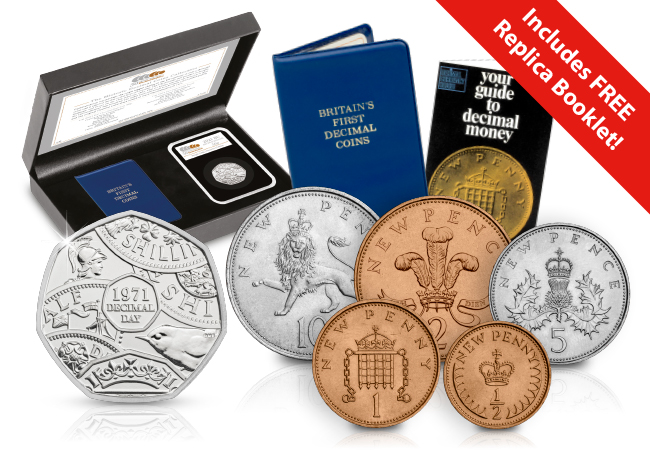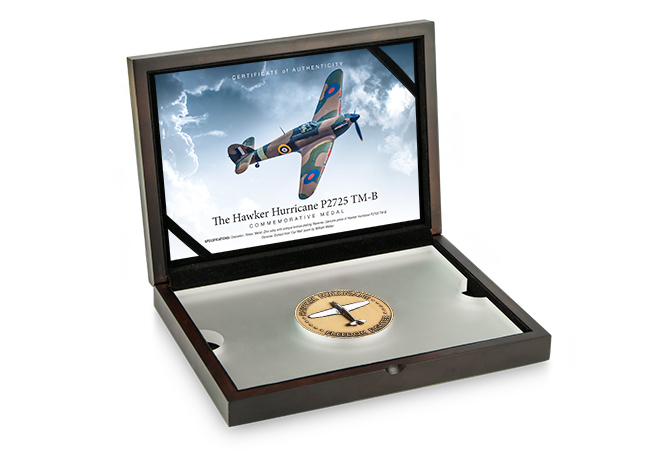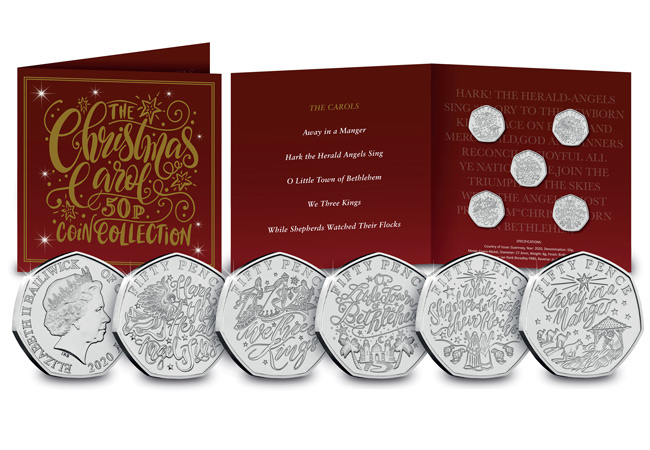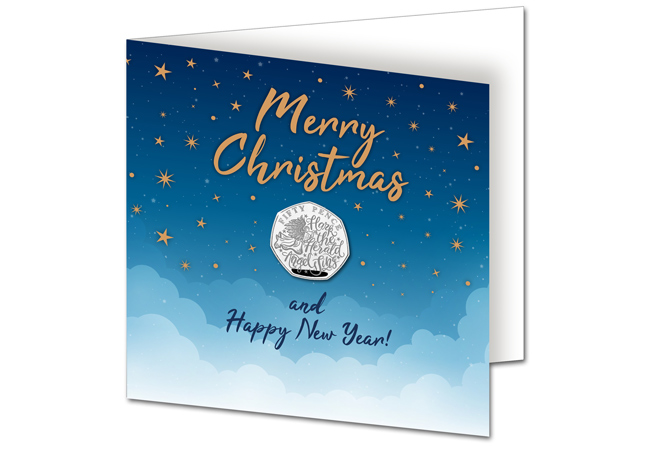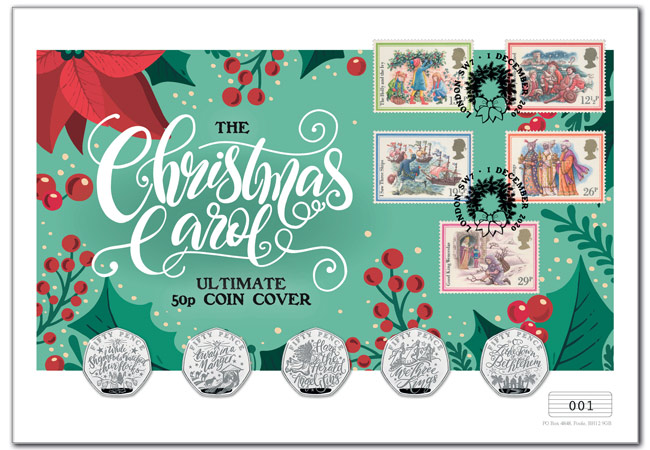British History
Decimalisation: Your top five questions answered
This year marks the 50th anniversary of the Decimalisation of our currency. On 15th February 1971, known as Decimal Day (or D-Day), the country switched to the decimal currency (based on multiples of 10 and 100) that we are familiar with today. But what happened on that day, and why is it important to collectors?
Before then, Britain used a monetary system that dated thousands of years back to the Roman Empire! The problem with the old Pounds, Shillings, and Pence system (sometimes called ‘old money’) is that it was based on multiples of 12 and 240. This made it quite confusing – there were 12 pennies in a shilling and 240 pennies in a pound, and 20 shillings made a pound – certainly not easy to add up in your head!
We get a lot of questions about Decimalisation, so before we celebrate the anniversary next month, we’ve answered some of your top questions about the biggest change to UK currency ever!

What were the coins called before Decimalisation?
The Pounds (£), Shillings (/-) and Pence (d) system included lots of coins with very different names to today’s coinage. A lot of these coins were given slang nicknames, such as ‘thrupence’ or ‘thrupny bit’ for a threepence, or a tanner for a sixpence. A Shilling was sometimes called a ‘bob’, and a ten shilling note would often be referred to as a ‘ten-bob‘ note.
| Pre-decimal Coin | Amount | Decimal Equivalent |
| Halfpenny | ½d. | 5⁄24p ≈ 0.208p |
| Penny | 1d. | 5⁄12p ≈ 0.417p |
| Threepence | 3d. | 1¼p |
| Sixpence | 6d. | 2½p |
| Shilling | 1/- | 5p |
| Florin | 2/- | 10p |
| Half Crown | 2/6 | 12½p |
| Crown | 5/- | 25p |
Who was the first country to go decimal?
Did you know the UK wasn’t the first country to go decimal? In fact, as early as 1704 Russia introduced the Ruble which was equal to 100 Kopecks, making it the first country to have a decimal coin. It was followed by France which introduced the Franc in 1795. Although the UK was one of the last to turn decimal, discussions first started in Britain as early as the 1820s, but the idea didn’t take off well with the public so it wasn’t until 150 years later that it actually happened.
When were the first decimal coins issued?
The first new decimal coins were actually issued before decimal day in 1971 – three years earlier in fact! In 1968 the plans for decimalisation were set in motion. To try and help the public acclimatise to the new decimal coins, the 5p and 10p, were issued, followed by the 50p a year later in 1969. This meant that the coins circulated alongside their pre-decimal siblings (Shilling, Florin, and 10 bob note) and were used interchangeably. By 1971 when the pre-decimal coinage ceased to be legal tender, only 3 new coins would be introduced (Half pence, one pence, two pence), making the jump to decimal currency a little easier for the public.
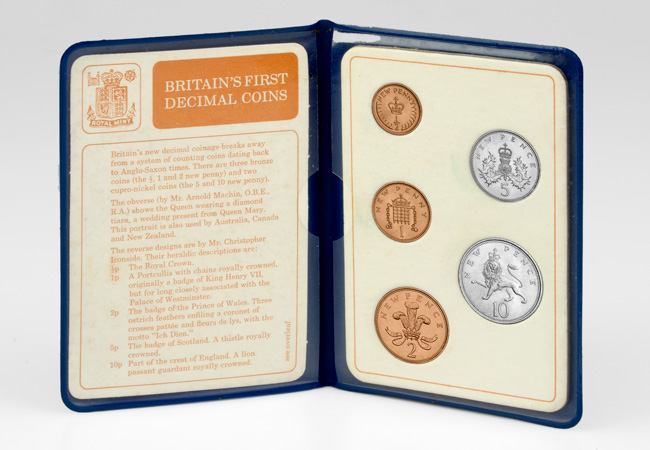
Why did the banks close for four whole days?
In 1971, very few banks used digital systems so on 10th February the banks closed for four days until Decimal Day. This allowed all outstanding cheques to be cleared in old money and all customers accounts to be converted into decimal coinage – and because most banks weren’t computerised, this had to be done manually! February was actually chosen as it was the quietest time of year for banks, shops, and public transport. It’s hard to imagine the banks closing for four days in a row now!
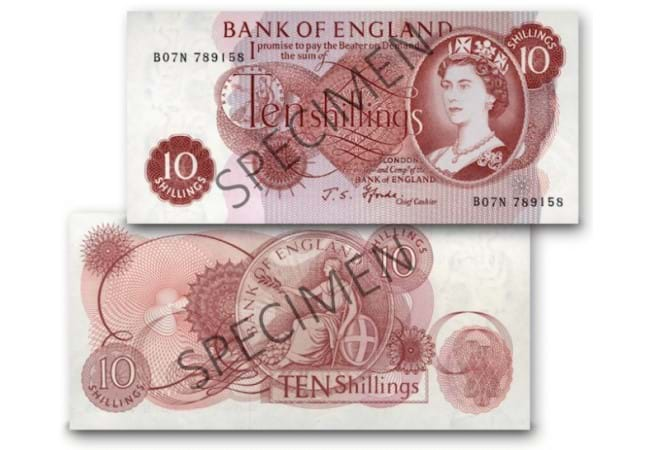
How did people compare between the two currencies?
Many people worried about shopkeepers inflating the prices of products during the changeover, but with a public information campaign that ran for almost 2 years prior, many people already had some idea of the conversions. And to help, currency convertors were made available to people, and shops displayed the prices in both currencies before and after Decimal Day. People could also continue to pay in old money, but they would receive their change in new money.
It took some time, but soon the decimal currency became familiar to everyone and continues to be the biggest change to UK coinage in thousands of years. In the lead up to the 50th anniversary, we’ll be issuing a series of blogs telling you all you need to know about this iconic moment in numismatic history, so make sure to stay tuned!
If you’re interested:
You can commemorate the 50th anniversary of Decimalisation now with the Historic Decimal Coins Collection! Including an ORIGINAL Decimal Coin Wallet, BRAND NEW BU 50p, and a FREE replica booklet. Click here to secure your Historic Decimal Coins Collection for JUST £29.99!
The day a Hawker Hurricane SAVED Buckingham Palace
On 15th September 1940 (later known as Battle of Britain Day), the Luftwaffe launched its largest and most concentrated attack against London in the hope of drawing the RAF to annihilation.
One German Dornier lagged behind and then started heading straight for Buckingham Palace. Sergeant Pilot Ray Holmes attempted to shoot it down before running out of ammunition. Without hesitation, he knew what he had to do; he had to hit it. At speeds in excess of 400mph, they collided.
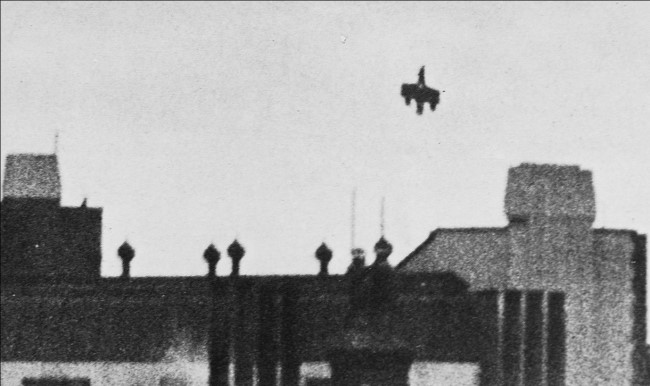
The Dornier crashed to earth, prevented from destroying the Palace. The Hurricane TM-B was also critically damaged and entered a vertical dive. Seeing there was no way to save the aircraft, an injured Holmes ejected to safety while the Hurricane plummeted to the ground, crashing where Buckingham Palace Road meets Pimlico Road and Ebury Bridge. Amazingly, these were the only two aircraft to crash on the City of London throughout the entire war.
The recovery of the remains…
Chris Bennett, a veteran of several aircraft excavations, decided to take on the project of excavating this famous aircraft; which was no easy task considering the Hurricane was buried underneath one of London’s busiest roads. After 13 years of planning and setbacks, he finally got the go-ahead to begin excavation, as well as TV production company Mentorn securing a spot on Channel 5 for a live broadcast!
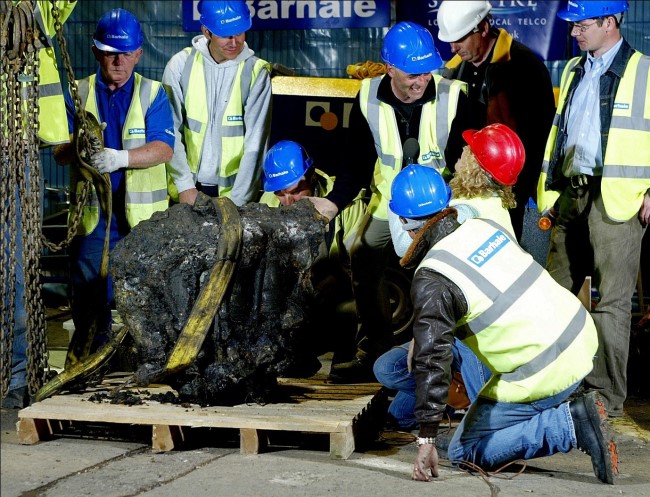
The recovered Merlin engine, along with other parts, were exhibited at the ‘Westminster at War’ exhibition in Leicester Square and then at the Imperial War Museum. The aluminium engine casing however, was melted down and cast into sculptures, the first two of which were presented to Ray Holme’s family and Her Majesty the Queen.
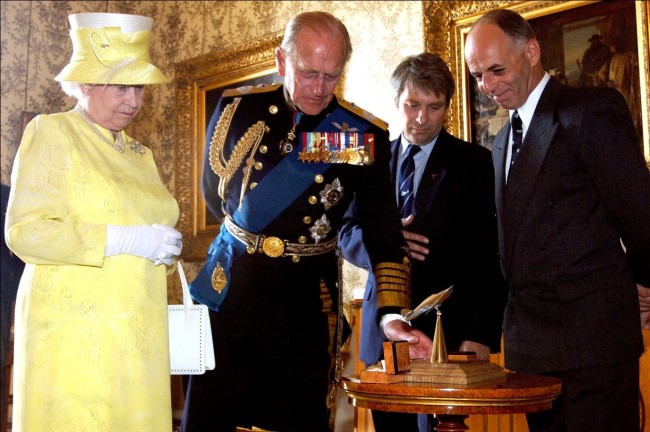
The BRAND NEW Hawker Hurricane Provenance Medal
And now, a small number of collectors have the chance to own a BRAND NEW Commemorative featuring an ACTUAL piece of the plane that Ray Holmes was flying on the 15th September 1940 when he saved Buckingham Palace!
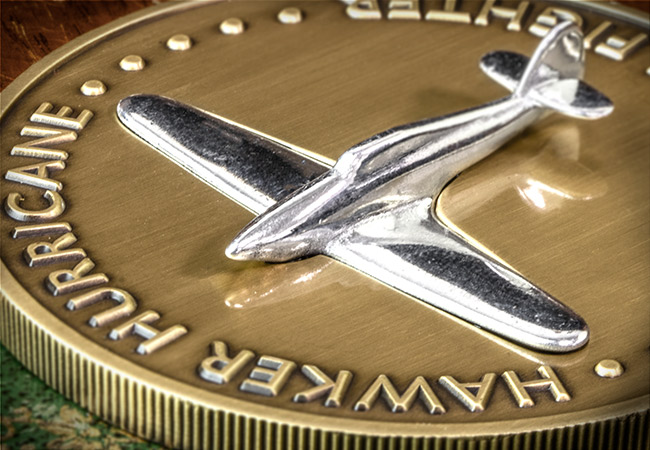
This incredible commemorative features an original piece of Hawker Hurricane, meticulously hand-sculpted into the shape of the iconic plane and precision set into the deluxe SUPERSIZE 70mm Medal.
Even without the genuine piece of Hawker Hurricane, this medal is a work of engineering art in its own right. Combined with the original piece of the Hawker Hurricane, you’d have to look for many years to find something better.
Just 250 lucky collectors have the chance to own this special new commemorative. Last year’s Provenance medal featuring a piece of Spitfire SOLD OUT in a matter of days. Click here to secure your Hurricane Commemorative while you still can!
FIVE BRAND NEW Christmas Carol 50p COINS REVEALED
Whether it’s in person or virtually this Christmas, we are ready to start singing from the hymn sheet as one of our favourite times of year approaches. And to make it even better, we can now reveal with great excitement our brand new Christmas Carol 50p Coins!
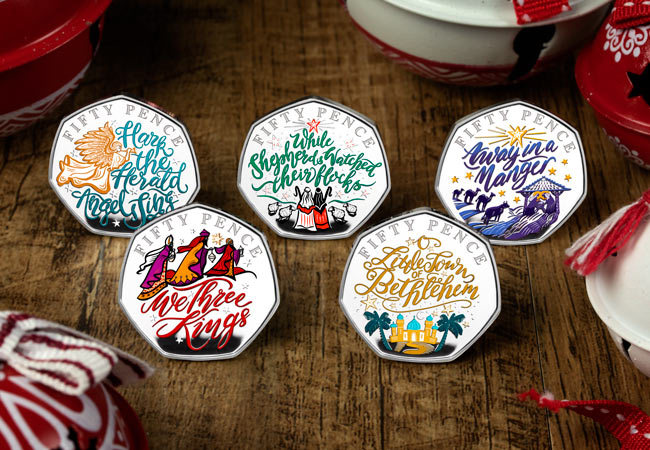
The tradition of singing Christmas Carols during the festive period dates back to the 19th century. In fact, it is believed that the Christmas Carol Service was invented in Truro by Edward White Benson, who later became the Archbishop of Canterbury.
These stunning new festive 50p coins celebrate some of the most renowned Christmas carols and I’m sure there are many of us, myself included, with very fond memories of singing carols throughout the festive season.
The FIVE new coins have been issued by Guernsey Treasury and are fully authorised by Her Majesty the Queen. Each feature a specially commissioned design by artist Jo Goodberry (you may remember she designed the incredibly popular Pantomime 50ps last year), including; Away in a Manger, Hark the Herald Angels Sing, O Little Town of Bethlehem, While Shepherds watched their flocks, and We Three Kings.
So whether you’re looking for the new centrepiece for your collection, you’re an avid 50p collector, or you’re looking for the perfect Christmas gift for a loved one, I’m sure you’ll love these new 50p coins.
Find out more about the different ways you can own these wonderful Christmas Carol 50p Coins below:
The Christmas Carol 50p Brilliant Uncirculated Coin Collection Pack
Over the last couple of years, new 50p coins have launched a whole new generation of collectors and so demand for these latest 50ps is expected to be very high. The coins will arrive ready to display in a customised presentation pack. You can secure the complete set of FIVE TODAY for only £30.00!
The Limited Edition 2020 Christmas Carol Silver Proof 50p Coin Collection
The coins you can see here have all been struck from .925 Solid Silver to a pristine Proof finish and feature selective colour printing. Importantly, this set is one of the only ways you can own all five of these designs. None will be released individually. With an extremely limited worldwide mintage of JUST 2,020 they’re not expected to be available for long.
Click here to secure yours today >>
The 2020 Christmas Carol 50p Christmas Card
The new Brilliant Uncirculated ‘Hark the Herald’ Christmas 50p is the only coin from the collection to be available on its own within this stunning Christmas card. What better way is there to wish family and friends a very Merry Christmas? Priced at just £7.99 it’s the perfect way to get ahead with your Christmas shopping this year.
The Christmas Carol Ultimate 50p Coin Cover
The ULTIMATE Stamp and Coin Cover is also available for pre-order. Featuring all five coins in Brilliant Uncirculated quality, this cover has been carefully paired with the elusive 1982 Royal Mail Christmas Carol stamps. These stamps are not easy to get hold of, and only 750 covers are being released worldwide with a postmark on the first day of Advent – 1st December 2020.
Prices start from just £7.99 so if you’re interested please click here to see the whole range >>

